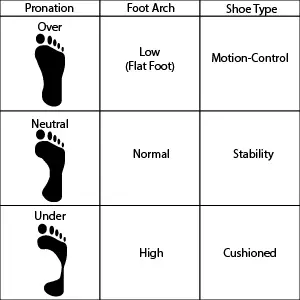You’ve heard the buzz about pronation, right? If not – don’t despair. Pronation only needs to be closely examined if you’re continuously having aches and kinks while running. Sometimes the problem isn’t even the shoes but possibly your gait or body form and movement.
There are some self-administered tests that you can use to check your pronation. Are they foolproof – no. The only way to truly check out your pronation is to have someone check your running gait. Normally this involves video so they can slow down it down and take a close look at the motion of your feet during your stride. Nowadays you can get a rough guess by just having someone you know to record behind you in slow motion. This is much easier on a treadmill because your body is in one place and it’s easier to see how your foot strikes the treadmill.
3 different types of foot strikes:
Supination (high arches/under) – is the opposite of pronation where your feet and ankle tend to roll to the outside when you foot strike.
Neutral (most people) – is where your foot strikes in the midsole of the show and doesn’t roll either way, thus a neutral strike.
Pronation (flat-footed/Low Arch/Over) – this occurs when your foot slaps flatly on the ground, in turn, causes your foot and ankle to roll inward.
Injuries depending on your foot strike.
This has been a tug of war for many years. I could at this moment go and search for correlated studies that would show you, heel strikers, are more injury prone and then another search says the complete opposite. The only big differences between the foot strikes was that heel strikers were more prone to overstriding. This isn’t saying that all heel strikers are over striders. Overstriding occurs when your legs extended beyond your hip and shoulders.
Do I need to get tested?
First of all, I’m an advocate of supporting your local shoe store, as long as they have trained individuals that know what they’re doing. I did a couple of tests that can be administered at home or with a running partner. I used the wet foot test (image below) to determine what type of shoe I needed to purchase. Basically, you get your feet wet and walk across the concrete.
Shoe Types
Low Arch = Motion control shoe
Normal Arch = Stability shoes
High Arch = Neutrally cushioned shoes
Conclusion
New runners tend to skip over buying the correct shoes. I know because I was once one of them. I, however, was lucky in that I had a neutral foot strike and so basically I found the most comfortable shoe to run in. If you’re either an Over/Under pronator you might consider getting a test at a running store.
| Help support me and subscribe to my YouTube channel. YouTube video - 30 ways to make your runs less painful! Coach Scott's Credentials:
|
To sign up for a FREE half marathon training schedule, log sheet, and pace predictor CLICK HERE.

Recommended gear for runners
Connect with me:
| facebook.com/BeginnerToFinisher/ |
